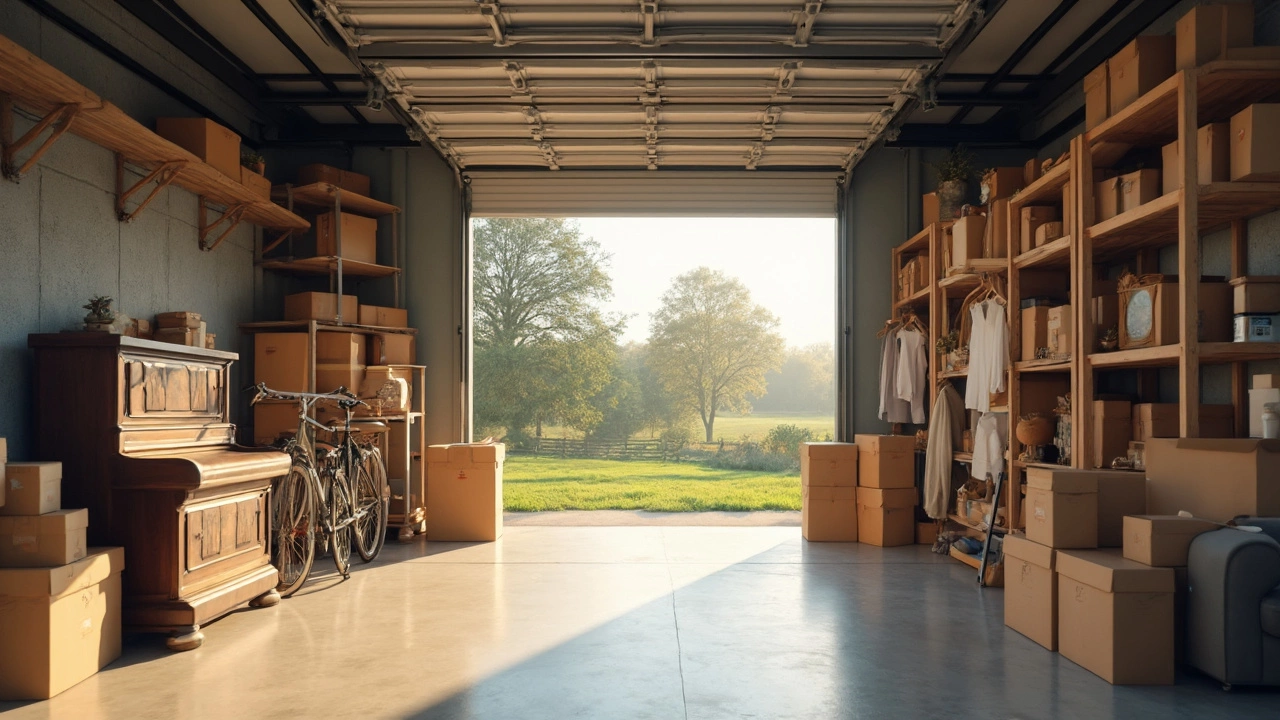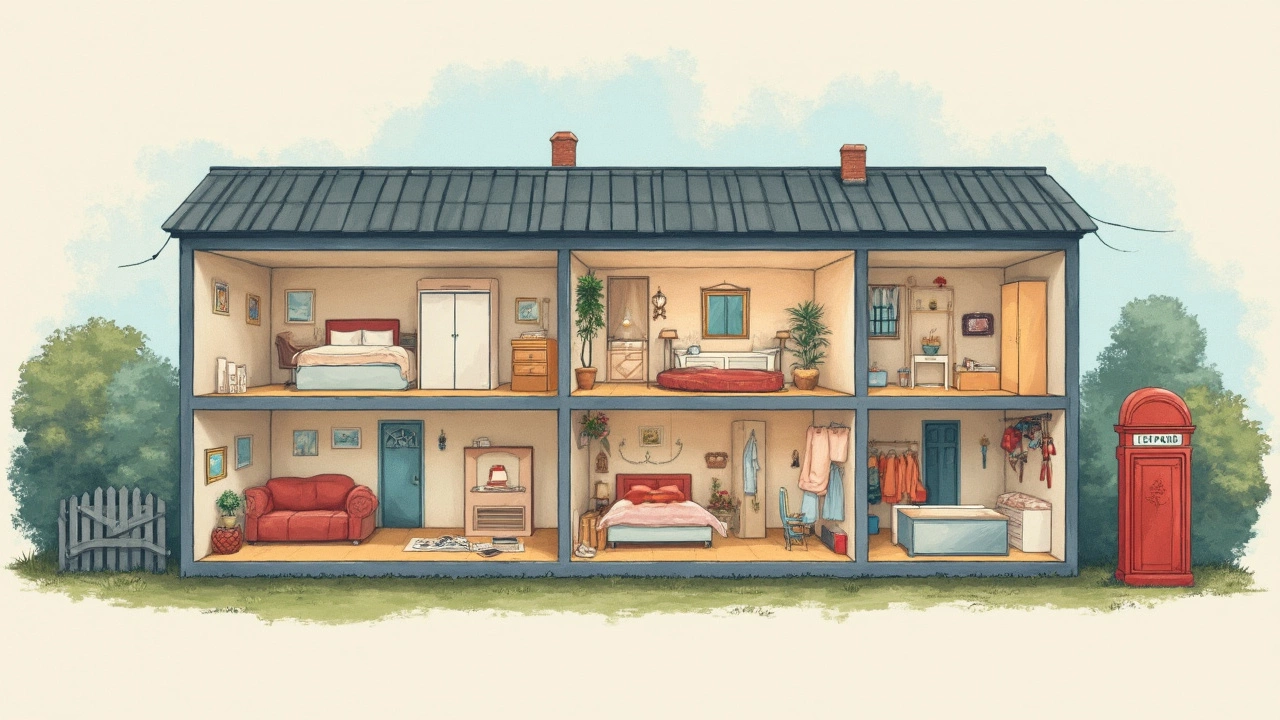How Many Rooms Does a 10x20 Storage Unit Hold? A Practical Guide

Ever looked at a 10x20 storage unit and thought, "There’s no way all my stuff will fit in there"? Spoiler: it probably will. That size is basically like having a standard one-car garage just for your boxes, furniture, and everything else you don’t want cluttering your living room.
If you’re trying to figure out what “10x20” means for your actual life, think of it this way—a typical storage unit this size holds the contents of a three- or even up to a four-bedroom house. That’s beds, dressers, couches, kitchen tables, and then some. For most families or roommates, even if you’ve got a hobby that eats up space (looking at you, paddleboard collectors), you’ll have room to spare if you pack wisely.
It helps to remember that you don’t need to leave walking paths between every box once it’s in storage. Stack high, fill every gap, and you suddenly get a lot more space for that awkward-shaped lamp you forgot you had. Don't guess—map out your biggest items first, like mattresses or the dining set, since those set the tone for how the rest fits in.
- What Does a 10x20 Storage Unit Hold?
- Room-by-Room Breakdown
- Packing Smart: Tips and Tricks
- Maximizing Your Space
What Does a 10x20 Storage Unit Hold?
A 10x20 storage unit might sound like just numbers, but we’re talking about 200 square feet of space. That’s enough to fit the entire contents of most three-bedroom houses, sometimes even a four-bedroom if you’re a smart packer. To put it in perspective, it’s about the size of a typical one-car garage—and you can stack stuff to the ceiling, usually eight feet or taller.
These units aren’t just for overflow when you’re moving. They work well for big life changes—like a major downsizing, combining households, or even stashing a business’s worth of inventory. If you’ve got a couple of couches, a full dining set, kid’s bedroom sets, and a wall of packed boxes, you’re still not maxing out a 10x20.
Here’s what can usually fit inside a 10x20 storage unit when you pack things efficiently:
- Four-bedroom house furniture (couches, beds, dressers, dining table, chairs)
- Major appliances (washer, dryer, fridge, freezer)
- 20–25 boxes of personal items
- Bikes, exercise gear, outdoor furniture
- Lawnmower or basic garden equipment
- Even a small car, motorcycle, or several kayaks
If you like numbers, check this out:
| Item Type | Average Quantity That Fits |
|---|---|
| Queen Beds | 2-3 with frames |
| Sofas or Sectionals | 2 large or 3 small |
| Dining Tables & Chairs | 1 set (seats 6-8) |
| Washer/Dryer Sets | 1 set |
| Standard Moving Boxes | 20-30 boxes |
| Bicycles | 3-5 |
Many storage facilities also let you access your stuff anytime, so you don’t need to stress if you packed the holiday decorations at the back. Just leave a little aisle when you pack.
Room-by-Room Breakdown
So, what does all your home stuff actually look like in a 10x20 storage unit? Let’s break it down by room, so you’ll know exactly what you can stash and what might need a second thought.
First off, most people renting this size unit are moving a multi-bedroom house. It handles it — we’re talking about the average contents of a three-bedroom place, sometimes even four if you don’t have a giant sectional couch or a grand piano. Here’s how it typically shakes out:
- Living Room: Most folks can fit a sofa, loveseat, coffee table, TV stand, large TV, bookshelves, and smaller items like chairs or end tables.
- Bedrooms: You’ll get in several beds (even queen size), dressers, nightstands, and boxes of clothes, bedding, or shoes. One king and two or three twin/queen beds? No sweat.
- Kitchen/Dining: Dining room set, china cabinet/hutch, and half a garage’s worth of small kitchen appliances you probably forgot about. Stack chairs upside down and slide tables on their edge to save space.
- Garage/Outdoor: Lawn mowers, bikes, and a pile of moving boxes packed with holiday decorations, sports gear, or tools go right in. Not much gets left out, unless you have a pool table (double-check your measurements!).
If you’re not sure how that all shakes out size-wise, here’s a snapshot to help visualize how many rooms fit comfortably in a 10x20 storage unit:
| Room/Area | Average Main Items That Fit |
|---|---|
| Master Bedroom | 1 king/queen bed, 2 dressers, 2 nightstands, boxes |
| Kids Bedroom | 1 twin/queen bed, dresser, nightstand, boxes |
| Living Room | Couch/sofa, armchair, TV, tables, shelves |
| Dining Room | Table, 6-8 chairs, buffet/hutch |
| Kitchen | Small appliances, boxes, pantry shelves |
| Garage/Other | Lawnmower, bikes, boxes, sports gear |
Don’t just take my word for it. According to U.S. Self Storage, “A 10x20 unit will accommodate the contents of a three- to four-bedroom house, offering enough space for furniture and personal belongings.”
“If you think in terms of how many bedrooms’ worth of stuff will fit, the 10x20 size is big enough for an average small family home.” – U.S. Self Storage
Just remember, everything depends on how you pack and whether you’re stashing full sets or just the essentials. If it’s all big, chunky furniture and no boxes, try measuring. But if you pack tightly and use vertical space, you’ll be impressed by how much you can fit from each area of your home.

Packing Smart: Tips and Tricks
Packing a 10x20 storage unit efficiently isn’t about being fancy—it’s about not wasting space or breaking your back. The trick is starting with a plan. Measure your big stuff first: mattresses, couches, dressers. Know their width, length, and height so you don’t end up stuck with a couch that won’t squeeze past the door. A lot of people underestimate just how high they can stack boxes, but most units are 8 feet tall. Use that vertical real estate. Stack heavy, sturdy items on the bottom and toss lighter boxes up top.
Here’s the move—disassemble what you can. Take legs off tables, take apart bed frames, and store hardware in labeled zip bags taped to pieces. You get more flexibility fitting everything together like a game of Tetris. If you’re packing fragile stuff, wrap it up well and keep those boxes at the very top. Tossing Grandma’s china under your dumbbells? Bad idea.
- Use same-sized boxes so stacking is easy and stable.
- Label boxes on all sides. That way, whatever side is visible, you know what’s in there without the shuffle.
- Keep a pathway down the center if you’ll need to reach things at the back.
- Furniture pads and moving blankets protect and fill up weird gaps.
- Store frequently-used items near the door so you don’t play hide-and-seek every visit.
For a quick look at how much you might be packing, check this table of average room contents and the approximate number of boxes or furniture items they take up:
| Room | Typical Contents | # Boxes | Large Items |
|---|---|---|---|
| Living Room | Books, decor, electronics, games | 10-15 | 2-3 Couches, 1 TV, 1 Coffee Table |
| Bedroom | Clothes, bedding, shoes, books | 8-12 | 1 Bed, 1 Dresser, 1 Nightstand |
| Kitchen | Dishes, pots, small appliances, pantry items | 10-20 | Dining Table, 4-6 Chairs |
| Garage/Extras | Sports gear, tools, seasonal decor | 10-15 | Bikes, Lawn Mower |
Don’t forget: odd-shaped things like bikes or lamps can fit in the spaces between furniture. Think in layers, not just stacks. And if you’re storing for a while, definitely skip boxes that aren’t sturdy—humidity and time can wreck the cheap ones. Spend a bit more, save a massive headache later.
Maximizing Your Space
Anybody can toss stuff into a storage unit and shut the door, but making the most of a 10x20 storage unit takes a little planning. If you want all your stuff to fit—and stay easy to access—you’ll need to think vertically, group smart, and avoid that tangled mess of boxes you see in cautionary storage tales.
Start by stacking your heavier items on the bottom and lighter boxes up top. Trust me, you’ll thank yourself when you don’t have a pancake-shaped box of family photos. Shelving units can really help here, especially for folks storing lots of smaller boxes or odd-shaped garage stuff. If you can, break down furniture like beds or tables to take up less space and make stacking simpler.
Label every box, even if you think you’ll remember what’s in it. (I’ve lost count of the times I’ve mixed up kitchen supplies and holiday decorations.) Put stuff you’ll want to grab sooner, like seasonal clothes or important papers, close to the door. Bulky furniture—couches, mattresses—usually go upright against the back wall. Use those weird, small spaces for lamps, garden tools, or anything that can slide in sideways.
- Disassemble furniture when possible—it saves a ton of room.
- Leave an aisle, even a small one, so you can reach things in the back.
- Stack suitcases and bins—they’re made for it.
- Consider vacuum-sealing clothes and bedding to shrink them down.
Surprisingly, a 2024 survey from the Self Storage Association showed that 82% of renters with a 10x20 unit said proper stacking and labeling saved them major headaches later.
| Tip | % of People Who Found This Usedful |
|---|---|
| Stacking boxes by weight | 91% |
| Using shelving units | 67% |
| Labeling boxes clearly | 84% |
| Disassembling large furniture | 76% |
It’s easy to underestimate how much fits with the right approach. So, spend a little time planning—it’s way better than digging through a giant cube of chaos later.